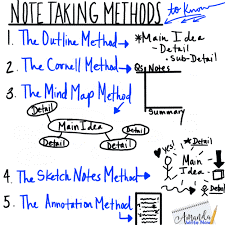Notes can be taken in any way that helps the student learn/study the topic, so our goal should be to advise students on their options so they can choose effectively. As an academic drop-in facilitator, I receive many questions about note-taking strategies. This strongly suggests that students really want teachers to scaffold/model effective note-taking for them. This may not always be part of the curriculum, but should always be taught anyways.
Note-Taking Methods
No single method will work for every student, thus, it’s worth being aware of the range of options. As examples, I will outline three of the most popular methods. It is important to recognize the differences between them, so that students can experiment and find the right fit for themselves.
1. Cornell Notes are designed to have an annotation area and an overview section. This makes them great for retaining and reviewing information, and great for understanding key ideas and relationships. Here is more information about Cornell note-taking. And here are some Cornell note-taking examples and free downloadable templates (click on the table of contents on the left). They are especially useful for students planning to make notes that they can review and update as part of the study process.
2. Outline Notes are effective for highlighting relationships between pieces of information. They use indents to group information together. While it’s easier to create them during the lecture, it’s difficult to organize the information after class. They are perfect for science and math subjects and best for easily creating study questions for review. Here is more information about outline note-taking.
3. Visual Notes can take many forms, from charts to mind maps, to sketch notes. As a more flexible system than outline notes, they can be ideal for visual learners. They are best for visualizing connected topics and ideas. Even though they might be challenging to create while listening, they can be valuable when students are organizing their thoughts after the lecture.
Suggestions that can work for any Note-Taking Approach
First, here is a list of abbreviations and symbols that students can use while note-taking. Undoubtedly these are useful, but students also need to understand that such quick fixes are not a substitute for thinking hard about selecting a suitable overall note-taking style.
Also applicable across approaches are the 3Rs of note-taking, which can help students remember the most important points:
1. Reflect: By adding a summary to your notes
2. Revise: Review your notes with a partner and add details that you missed, or look in your textbook and add details
3. Review: Fold your notes so that the questions/keywords show, but the notes do not. This is simplest to do with Cornell Notes but can work with other styles too. The key point is to quiz yourself; the review will enhance your retention of the material.
Paper Notes vs Digital:
As an instructor, I encourage old-school note-taking (pen and paper) because many research studies indicate that taking pen and paper notes increases ability to concentrate, and improves comprehension and retention of lecture materials more than typing notes. However, this may also be a matter of learning style preference. Therefore, for students who prefer to take notes on digital devices to keep track of their learning, here are the best note-taking apps (some, like Evernote, Simplenote, Bear, Dropbox Paper, and Google Keep can be free).
Finally, how do you assist your students with taking effective notes? Leave a comment below if you would like to share.


Very Informative!
Thank you, Jiya!
Well done, Gönül. I enjoy your articles because they make me look inward as an educator.
As a teacher, I fight the urge to convince students to take notes in the fashion that I think is correct and grew up with.
What do you do if a student says they take notes “my way” but you see the notes are incomplete, inaccurate or lacking?